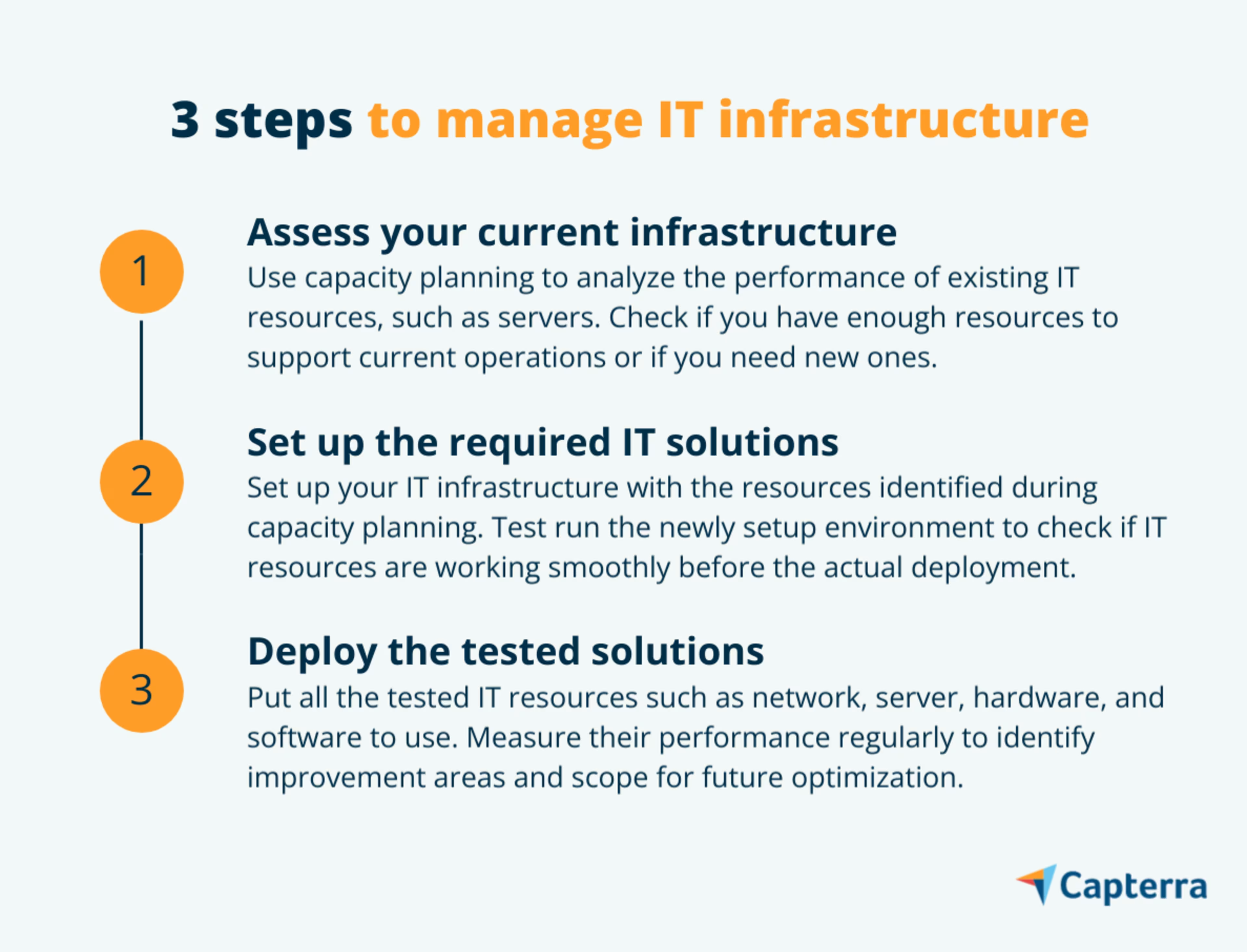An IT infrastructure management guide to boost employee efficiency and scale operations without hassles.
Your employees depend on technology to do their jobs, and as a business owner, you need to provide the technology resources they need to work effectively. Operational issues such as hardware breakdowns and poor internet connectivity hinder your employees’ workflows, and in most cases, the reason is mismanaged information technology (IT) infrastructure.
IT infrastructure—which comprises components such as hardware, software, network, and server—helps your business achieve its operational goals so employees can work without any interruptions. IT infrastructure components work together to facilitate smooth communication, fast exchange of information, and secure data sharing at your digital workplace.
Well-managed IT infrastructure not only enhances employee efficiency but also allows your IT team to scale operations without any hassles. In this guide, we explain the three steps to effectively manage your IT infrastructure and facilitate a smooth-functioning digital workplace supported by the right technology solutions.
Why your small business should focus on IT infrastructure
As your small business grows, you’ll have to scale your traditional IT infrastructure to make room for new technology resources. You’ll need to upgrade IT servers to accommodate an increasing number of users, applications, and network devices. With the right IT infrastructure, you can not only meet the growing IT needs of your small business but also protect it against security risks, such as cyberattacks.

Find providers that can help with your business needs by using our lists of IT services agencies by location.
1. Assess current infrastructure through capacity planning
The first step is to understand and analyze the abilities of your existing infrastructure ecosystem, and the capacity planning process can help you do that. It measures how well the IT infrastructure components support your business’s daily operations and workflows.
Capacity planning lets you assess the components based on their ability to assist with tasks such as data storage and network connectivity. It helps identify gaps and fix them to prevent any potential downtime or security risks. It also assists in understanding if you should scale your infrastructure ecosystem and to what extent.
There are three types of capacity planning:
Hardware capacity planning: Checks the capacity of hardware devices such as computers and hard disk drives to support your business’s IT environment.
Workforce capacity planning: Analyzes if you have the right talent (e.g., IT infrastructure managers) to optimally use the infrastructure components.
Software capacity planning: Assesses if you have the right software solutions to ensure the smooth operation of IT infrastructure components.
How to ace capacity planning
Measure: Conduct a detailed analysis of the performance of physical as well as virtual IT resources, such as storage systems and servers. Focus the analysis on the resources’ ability to address technical issues and help employees do their jobs.
Determine: Use the analysis to determine if your business has sufficient IT resources to support existing operations and if they are being fully utilized. This will help identify if you need completely new resources or you could simply upgrade the existing ones.
Plan: Prepare a list of required resources and plan a budget for their purchase. Buying IT resources is expensive, so prioritize your purchases by considering what benefits a new resource will bring to your IT infrastructure.
pro tip
Use infrastructure monitoring tools such as network monitoring to get a clear picture of how your IT infrastructure components are performing. Networking monitoring tools help evaluate IT infrastructure performance to optimize IT resource utilization and analyze the scope for improvement.
2. Set up required IT solutions through provisioning
Provisioning is the process of setting up your IT infrastructure with the resources identified during the capacity planning phase. For example, setting up a data center with required storage and server equipment.
There are four types of provisioning in IT infrastructure management:
Network provisioning: Setting up an IT network that aids connectivity between infrastructure components, users, devices, etc.
Server provisioning: Setting up servers that operate within the network. This step includes installing hardware devices and software tools (operating system and apps).
User provisioning: Managing user access to business resources, networks, and systems by assigning access rights and authorization privileges.
Service provisioning: Creating a required service (such as cloud computing) and managing all the data related to that service.
How to ace provisioning
Set up resources. Collect all the required IT resources and set them up in their order of usage for work processes.
Test the setting. Test run the newly set up environment to check if IT resources are working smoothly before the final deployment. You can change the order of resources based on their utility or performance.
Focus on technology enhancements. Simplify and accelerate processes using technology. You can, for instance, use software solutions to automate the provisioning of infrastructure components or use artificial intelligence (AI) to standardize work processes and reduce human dependency or errors.
Read our primer onwhy you should automate your IT infrastructure.
pro tip
Ask these questions when adopting a new IT resource:
Does it introduce new solutions into your existing work processes?
Does it enhance the employee experience?
Does it improve the speed or reduce the cost of existing work processes?
For any new technology, if the answer to any of the questions above is yes, then consider investing in that technology.
3. Deploy the tested IT solutions
During deployment, you put all the tested IT resources such as network, server, hardware, and software to use. Once the resources are deployed, your IT infrastructure team should monitor them regularly to measure performance, identify improvement areas, and suggest action points for future optimization.
There are five types of deployment strategies you can choose from:
Canary deployment: Slowly roll out the changes to a small group of users and gradually expand to mitigate risks. This deployment type is mostly used in cases of budget or resource constraints.
Blue-green deployment: Use the old solutions parallel to new solutions for work processes, and switch to any of them in real time based on work requirements. This method is mostly used when businesses want to use both old and new resources.
Recreation deployment: Shut down the old solutions completely before deploying the new ones. This is a full reboot technique to ensure proper alignment of new and old resources.
Shadow deployment: Use both old and new solutions, one at a time, to aid work processes. Don’t switch in real time like in the blue-green deployment type.
AB testing deployment: Use real-world scenarios to decide the use of old or new technology solutions. The strategy is often combined with the canary deployment model and used when running different versions of the same work process.
How to ace deployment
Allocate: Introduce the new components into your business’s IT infrastructure and align them to current processes.
Monitor: Track the performance of the new components to check how well they’re assisting work processes as well as how your IT infrastructure is performing as a whole.
Optimize: Identify the scope of improvements against the current performance and devise a plan to optimize the components for maximum efficiency.
pro tip
Use Gartner’s maturity assessment test (full research available to Gartner clients) to identify the most promising action plan based on your current as well as future needs. The test helps your infrastructure manager identify improvements that add value and offers actionable insights to maintain a solid IT infrastructure.
Upgrade your digital workplace with effective IT infrastructure management
Real-time monitoring and base-level management of technology components are the key to successful IT infrastructure management. Well-managed IT infrastructure allows you to use technology resources to their full capacity and leverage them to streamline work processes and operations.
To get IT infrastructure management right, you need to know the best practices and how they add value to your business operations. Here are related Capterra resources on best practices for IT infrastructure management:
